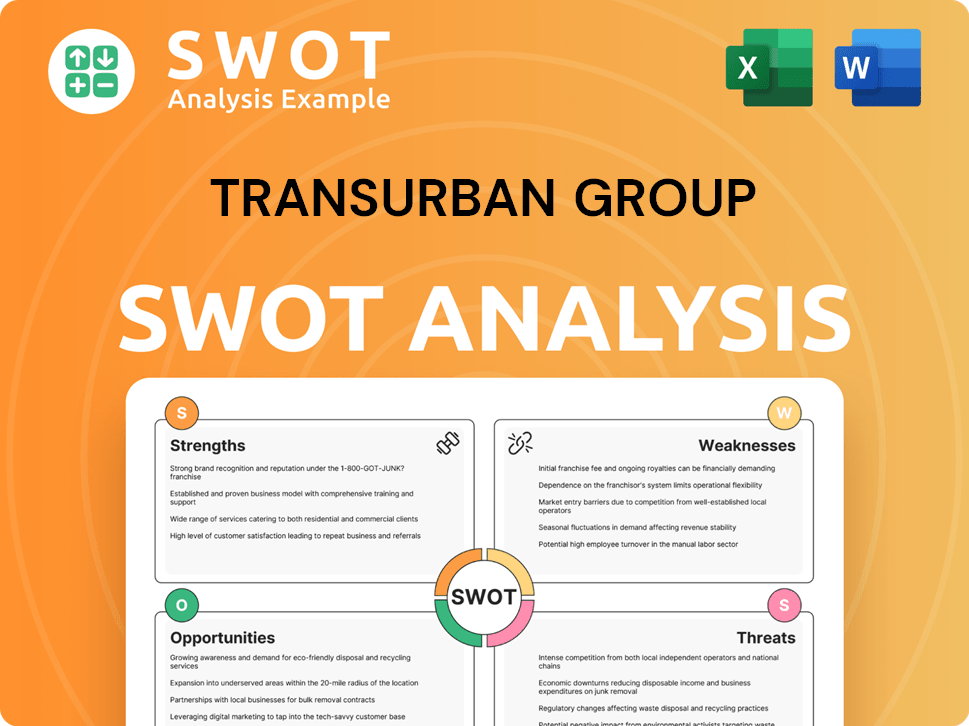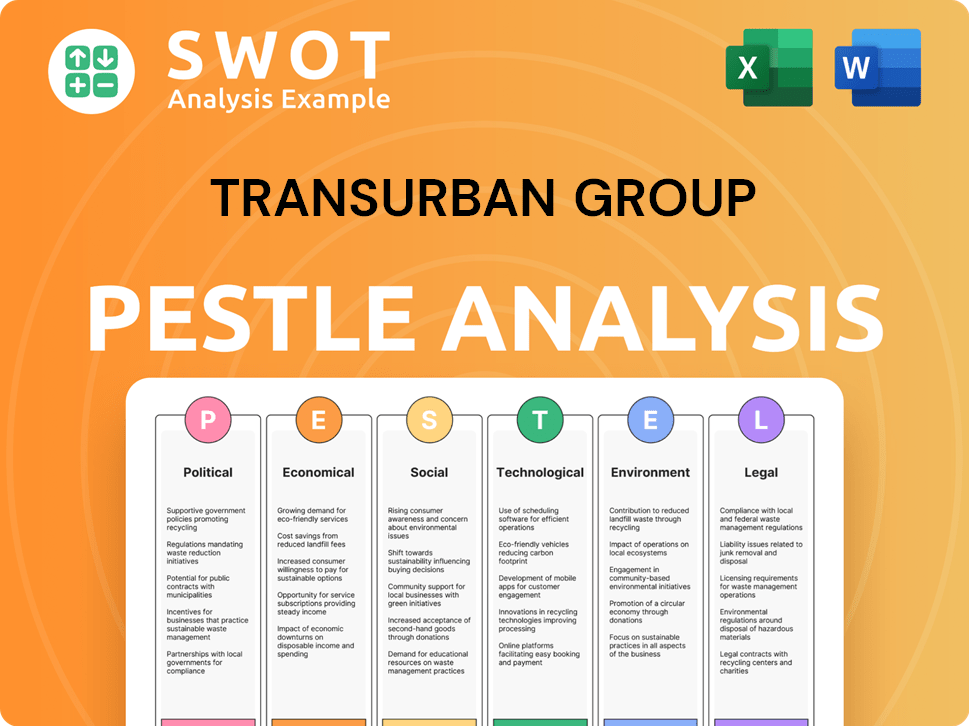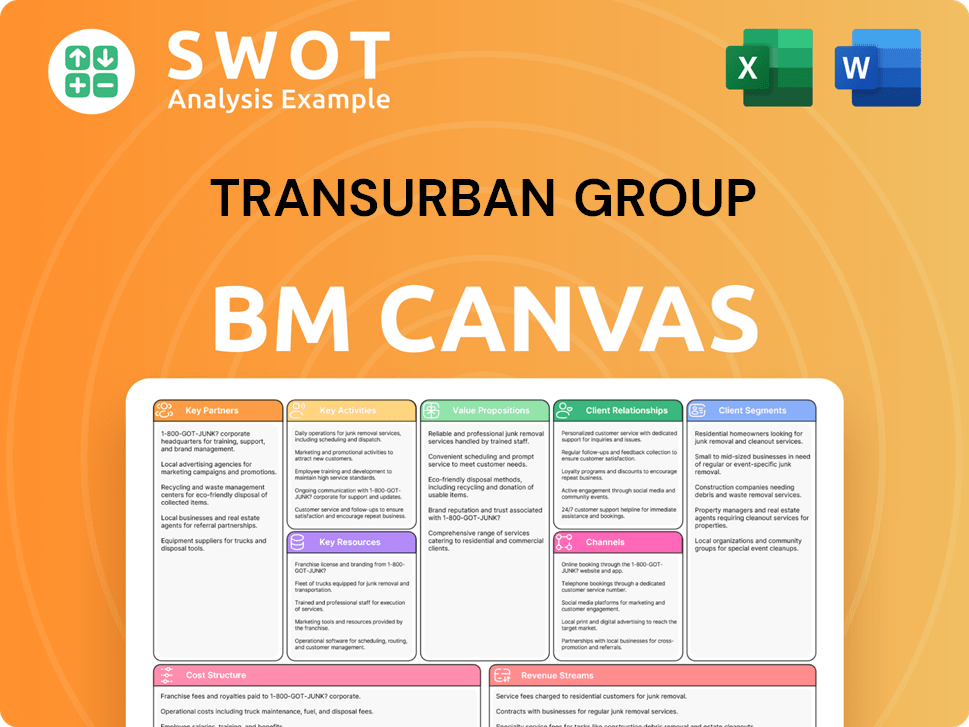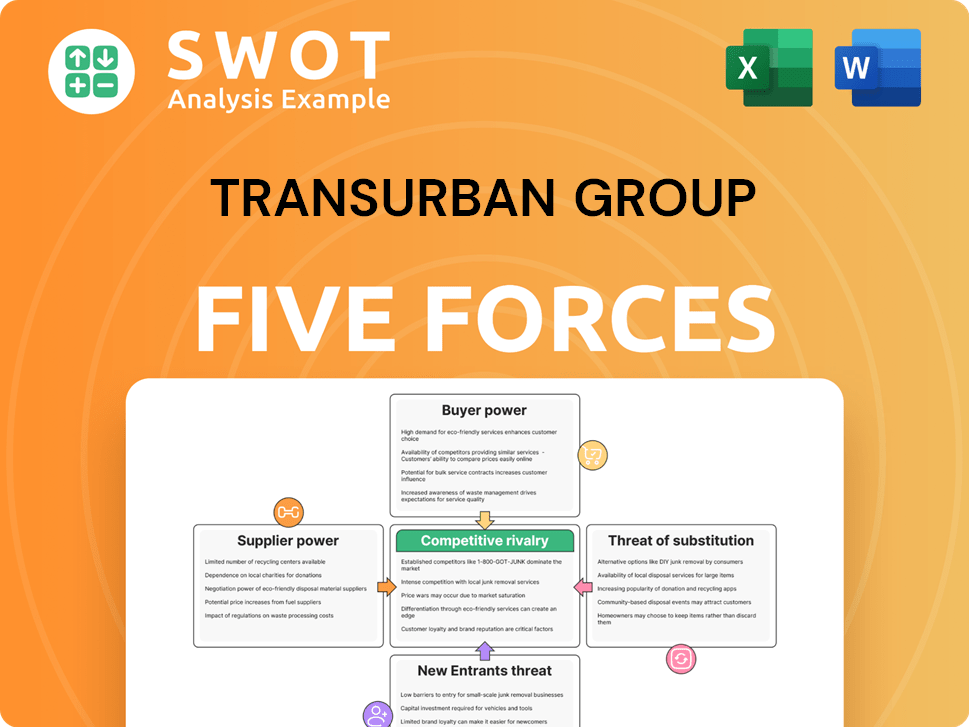Transurban Group Bundle
How Does Transurban Group Drive Success Beyond Tolls?
Transurban Group, a global leader in toll road development, operates in a unique market where building trust and showcasing value are paramount. Unlike traditional product sales, their approach focuses on fostering seamless customer experiences and strong stakeholder relationships. This strategy is crucial for securing new projects and maintaining public acceptance of essential infrastructure. This article dives deep into the Transurban Group SWOT Analysis, exploring the company's innovative sales and marketing tactics.

From securing government concessions to building direct customer relationships through digital platforms, Transurban's evolution reflects a deep understanding of user needs. This comprehensive analysis explores the intricacies of Transurban's sales strategy, including its toll road marketing, and how it navigates a complex landscape. We'll examine their customer acquisition strategies, digital marketing initiatives, and public relations strategy, providing actionable insights for investors and business strategists alike. Understanding these elements is key to grasping Transurban's sustained growth and its ability to thrive in the infrastructure investment sector, especially in the competitive landscape of traffic management solutions.
How Does Transurban Group Reach Its Customers?
The sales channels for Transurban, a leading toll road operator, differ significantly from those of traditional businesses. Its primary focus is on securing concessions and managing user access to its toll road networks. Revenue generation hinges on toll collection, facilitated through electronic and digital channels. This approach is central to its Transurban sales strategy.
The company leverages its website and mobile applications as crucial online platforms for account management, trip planning, and payment. These digital interfaces represent the main direct-to-customer interaction point for road users. For instance, systems like Linkt in Australia provide a streamlined digital experience, enabling automatic toll payments and real-time balance checks. This strategic shift towards digital adoption minimizes physical interactions and enhances efficiency.
The evolution of these channels has been driven by technological advancements and a focus on customer convenience. Electronic tolling systems, introduced in the early 2000s, reduced the need for physical toll booths, transitioning users to transponder-based or license plate recognition systems. More recently, the emphasis has been on enhancing mobile app functionalities and integrating with in-car technology, reflecting a strategic shift towards omnichannel integration for seamless user journeys, which is a key part of the Transurban marketing strategy.
Transurban's website and mobile apps are key for account management, trip planning, and payments. These platforms offer a direct-to-customer interface, enhancing user experience. They are crucial for managing toll road access and facilitating transactions, which is integral to the Transurban Group's operational model.
Electronic tolling, including transponders and license plate recognition, has replaced physical toll booths. This technology speeds up traffic flow and improves customer satisfaction. It is a core component of the company's infrastructure investment strategy.
Collaborations with government agencies and local authorities are essential for securing new projects. These partnerships are crucial for expanding the company's footprint. Such collaborations are vital for Transurban Group's long-term growth and development.
Enhancing mobile app functionalities and integrating with in-car technology is a strategic focus. This omnichannel approach ensures seamless user journeys. This integration enhances the user experience and supports the company's digital marketing initiatives.
Transurban collaborates with government agencies and local authorities for infrastructure projects. Digital platforms, such as Linkt, streamline user experiences through account management and automatic payments. These efforts are part of Transurban's customer acquisition strategies.
- Partnerships with government agencies are critical for securing new projects and expanding their footprint.
- Digital platforms like Linkt provide streamlined digital experiences for account holders.
- Focus on enhancing mobile app functionalities and integrating with in-car technology.
- These strategies are vital for the company's sales performance indicators.
Transurban Group SWOT Analysis
- Complete SWOT Breakdown
- Fully Customizable
- Editable in Excel & Word
- Professional Formatting
- Investor-Ready Format

What Marketing Tactics Does Transurban Group Use?
The company, Transurban Group, employs a multifaceted marketing strategy to enhance brand awareness, manage its public image, and build strong relationships with its stakeholders. This approach includes a blend of digital and traditional marketing tactics, all designed to effectively communicate with road users, government bodies, investors, and local communities. The core of its strategy revolves around providing clear and accessible information, managing traffic efficiently, and fostering positive public perception of its infrastructure projects.
Digital channels are central to Transurban's marketing efforts, with a strong emphasis on content marketing and online platforms. These strategies are complemented by targeted advertising and direct communication methods, ensuring that key messages reach the intended audiences. The company also utilizes traditional media and data analytics to optimize its marketing campaigns and improve customer engagement. This comprehensive approach helps Transurban maintain its market position and enhance the value of its infrastructure investments.
Transurban's marketing strategy is designed to support its overall business goals, including revenue generation and stakeholder engagement. Through a combination of digital and traditional marketing tactics, the company aims to improve user experience, manage public perception, and drive sustainable growth. This approach is essential for the company's long-term success in the competitive infrastructure market.
Transurban heavily relies on digital marketing, utilizing its corporate website and customer platforms like Linkt for content marketing. This includes providing information on road network performance, project updates, and travel tips. The company focuses on optimizing its online presence for relevant infrastructure and travel-related searches.
Paid advertising is a key component of Transurban's strategy, particularly in local markets. These campaigns inform the public about new road openings, traffic changes, and specific initiatives. The company strategically uses advertising to reach a broad audience and disseminate important information.
Email marketing is a critical tool for direct communication with account holders. Transurban uses email to provide statements, service updates, and personalized travel information. This method ensures that customers receive relevant and timely information directly.
Social media platforms like X, LinkedIn, and Facebook are actively used for community engagement, real-time traffic updates, and responding to customer inquiries. This demonstrates Transurban's commitment to transparency and responsiveness. Social media helps in building a community around the brand.
Transurban also leverages traditional media, including local TV and radio, for broader public awareness campaigns. These campaigns are often related to major road projects or traffic management during peak periods. Traditional media helps in reaching a wider audience.
The company employs data-driven marketing by analyzing traffic patterns, customer feedback, and usage data to optimize road performance and tailor communication. This approach ensures that marketing efforts are effective and aligned with customer needs. Analytics tools are used to monitor website traffic, social media engagement, and campaign effectiveness.
Transurban's marketing strategy focuses on digital channels, targeted advertising, and direct communication to engage with stakeholders. The company's approach to Revenue Streams & Business Model of Transurban Group includes a blend of traditional and modern marketing techniques, all designed to enhance brand awareness and manage public perception. This multi-faceted approach supports the company's overall business goals.
- Digital Engagement: Utilizing websites, customer platforms, and social media for content and information dissemination.
- Targeted Advertising: Employing paid advertising in local markets to inform the public about road projects and traffic updates.
- Direct Communication: Using email marketing to provide account holders with statements, service updates, and personalized travel information.
- Community Engagement: Actively using social media for real-time updates and responding to customer inquiries.
- Traditional Media: Leveraging local TV and radio for broader public awareness campaigns.
- Data Analytics: Analyzing traffic patterns and customer feedback to optimize road performance and tailor communication.
Transurban Group PESTLE Analysis
- Covers All 6 PESTLE Categories
- No Research Needed – Save Hours of Work
- Built by Experts, Trusted by Consultants
- Instant Download, Ready to Use
- 100% Editable, Fully Customizable

How Is Transurban Group Positioned in the Market?
The brand positioning of the company, a key player in the infrastructure sector, centers on 'connecting communities' and 'improving urban mobility.' This approach differentiates it from competitors by emphasizing its role as an essential partner in urban development. The company's brand narrative highlights its commitment to reducing congestion and enhancing travel times, which supports economic growth.
Its visual identity often includes imagery of flowing traffic, modern infrastructure, and cityscapes, conveying efficiency and progress. The tone of voice is typically informative, authoritative, and reassuring, emphasizing safety and reliability. The customer experience promises seamless journeys and convenience through technology, such as electronic tolling and real-time traffic information. This focus is crucial for effective Transurban marketing strategy.
The company's unique selling proposition is delivering long-term, sustainable infrastructure solutions to its target audiences, including road users, governments, and investors. For road users, the appeal is convenience and time savings; for governments, it's the ability to fund and deliver critical infrastructure without sole reliance on public funds; and for investors, it's the stable, long-term returns from essential assets. This approach is central to the company's overall Transurban sales strategy.
The core message revolves around 'connecting communities' and 'improving urban mobility,' solidifying the company's position in the market. This message is consistently communicated across all platforms to maintain brand consistency. The company's focus on enhancing travel experiences and supporting economic growth is a key element of its brand identity.
The visual identity incorporates imagery of flowing traffic, modern infrastructure, and cityscapes. This visual approach is designed to convey efficiency and progress. The use of these elements helps to create a strong and recognizable brand presence in the infrastructure sector.
The tone of voice is typically informative, authoritative, and reassuring, emphasizing safety and reliability. This tone is crucial for building trust with both customers and stakeholders. The consistent use of this tone across all communications reinforces the company's commitment to its values.
The customer experience focuses on seamless journeys and convenience through technology, such as electronic tolling and real-time traffic information. This commitment to convenience enhances customer satisfaction. The use of technology is a key differentiator in the competitive toll road market.
The company actively responds to shifts in consumer sentiment, particularly regarding tolling affordability and environmental impact, by emphasizing the broader benefits of its infrastructure and investing in initiatives like smart motorways to optimize traffic flow and reduce emissions. This proactive approach to environmental concerns is a key part of its Transurban Group strategy. The company's commitment to sustainability is evident in its initiatives to reduce emissions and improve traffic flow. The company's data-driven marketing techniques are employed to better understand customer needs and preferences, which is essential for effective toll road marketing. The company's focus on customer relationship management helps to maintain strong relationships with its customers.
The company appeals to road users, governments, and investors. For road users, the appeal is convenience and time savings; for governments, it's the ability to fund and deliver critical infrastructure without sole reliance on public funds; and for investors, it's the stable, long-term returns from essential assets. This multi-faceted approach ensures broad appeal.
The USP is delivering long-term, sustainable infrastructure solutions. This focus differentiates the company in the market. This approach ensures long-term value for all stakeholders.
Brand consistency is maintained across corporate communications, customer-facing platforms, and engagement with government and community stakeholders. This consistency builds trust and recognition. The company uses a unified approach across all its platforms.
The company actively responds to shifts in consumer sentiment, particularly regarding tolling affordability and environmental impact. This responsiveness helps maintain a positive brand image. The company invests in initiatives like smart motorways to optimize traffic flow and reduce emissions.
The company invests in initiatives like smart motorways to optimize traffic flow and reduce emissions. This commitment to sustainability is a key part of its brand strategy. These initiatives enhance its reputation and appeal to environmentally conscious consumers.
The company uses technology to enhance the customer experience, such as electronic tolling and real-time traffic information. This integration improves convenience and efficiency. The use of technology is a key differentiator in the competitive market.
In the 2024 financial year, the company reported strong financial results, with revenue and traffic volumes increasing across its portfolio. Specifically, the company's focus on infrastructure investment has yielded positive returns. The company's market share in toll roads remains significant, demonstrating the effectiveness of its strategies.
- Revenue growth of approximately 7% compared to the previous year.
- Traffic volume increases of 5% across key assets.
- Strong investor confidence, reflected in stable share prices and dividend yields.
- Continued expansion of its infrastructure portfolio through strategic acquisitions and project developments.
Transurban Group Business Model Canvas
- Complete 9-Block Business Model Canvas
- Effortlessly Communicate Your Business Strategy
- Investor-Ready BMC Format
- 100% Editable and Customizable
- Clear and Structured Layout

What Are Transurban Group’s Most Notable Campaigns?
For a toll road operator like the company, the term 'campaigns' leans more towards public awareness and stakeholder engagement than traditional product launches. The core focus is on demonstrating the value of infrastructure projects and fostering positive relationships with the community. These efforts are crucial for maintaining a strong brand reputation and ensuring the successful integration of new road networks.
A significant ongoing 'campaign' revolves around the development and opening of new road networks or major upgrades. The West Gate Tunnel Project in Melbourne, with an expected completion in 2025, serves as a prime example. These campaigns aim to inform the public about construction progress, manage expectations regarding traffic impacts, and highlight the benefits of the new infrastructure, such as reduced travel times and improved safety. Effective communication is essential for encouraging the adoption of new routes.
These campaigns leverage a mix of channels including dedicated project websites, social media updates, local community meetings, and traditional media advertisements. The creative concept often involves visualizations of the completed project, testimonials from community leaders, and clear explanations of the project's features and benefits. Success is measured by public awareness, positive sentiment, and the seamless integration of the new infrastructure. Collaborations with local councils and community groups are vital for building trust and addressing local needs.
The company invests heavily in public awareness campaigns surrounding its infrastructure projects. These campaigns use various media channels to inform the public about construction progress, traffic impacts, and the benefits of new routes. These campaigns are key to the company's Owners & Shareholders of Transurban Group.
Stakeholder engagement is a critical aspect of the company's strategy. This involves collaborating with local councils and community groups to address concerns and build trust. Transparent communication and community involvement are crucial for project success.
The company utilizes digital platforms, including dedicated project websites and social media, for real-time updates and information dissemination. These platforms help manage expectations and keep stakeholders informed about project developments. This is a key part of the Transurban marketing strategy.
The company's communication strategies around unexpected road closures or major incidents are crucial for maintaining its brand reputation. Real-time information and public safety are integral to building and maintaining trust. This is a key element of its traffic management solutions.
Dedicated project websites offer detailed information about ongoing construction and upcoming changes. These sites are essential for providing comprehensive updates and answering public inquiries. They are a core part of the Transurban sales strategy.
Social media platforms are used for real-time updates and announcements, helping the company to quickly disseminate information. This approach is particularly effective for managing traffic-related concerns and providing immediate alerts. This is a key component of the company's digital marketing initiatives.
Local community meetings provide a platform for direct interaction and feedback. These meetings are crucial for addressing specific concerns and building relationships with local communities. This enhances the company's public relations strategy.
Traditional media, including TV, radio, and print, is used to reach a broad audience and provide comprehensive information. Advertisements and public service announcements help to ensure widespread awareness of project updates. These campaigns support the company's advertising campaigns analysis.
The company uses data-driven insights to monitor the effectiveness of its campaigns and make necessary adjustments. This includes analyzing website traffic, social media engagement, and media mentions to optimize communication strategies. This is a key part of Transurban's data-driven marketing techniques.
Customer relationship management (CRM) systems help the company manage interactions with stakeholders and address their needs. This includes tracking inquiries, complaints, and feedback to improve customer satisfaction. This supports Transurban's customer relationship management.
Transurban Group Porter's Five Forces Analysis
- Covers All 5 Competitive Forces in Detail
- Structured for Consultants, Students, and Founders
- 100% Editable in Microsoft Word & Excel
- Instant Digital Download – Use Immediately
- Compatible with Mac & PC – Fully Unlocked

Related Blogs
- What are Mission Vision & Core Values of Transurban Group Company?
- What is Competitive Landscape of Transurban Group Company?
- What is Growth Strategy and Future Prospects of Transurban Group Company?
- How Does Transurban Group Company Work?
- What is Brief History of Transurban Group Company?
- Who Owns Transurban Group Company?
- What is Customer Demographics and Target Market of Transurban Group Company?
Disclaimer
All information, articles, and product details provided on this website are for general informational and educational purposes only. We do not claim any ownership over, nor do we intend to infringe upon, any trademarks, copyrights, logos, brand names, or other intellectual property mentioned or depicted on this site. Such intellectual property remains the property of its respective owners, and any references here are made solely for identification or informational purposes, without implying any affiliation, endorsement, or partnership.
We make no representations or warranties, express or implied, regarding the accuracy, completeness, or suitability of any content or products presented. Nothing on this website should be construed as legal, tax, investment, financial, medical, or other professional advice. In addition, no part of this site—including articles or product references—constitutes a solicitation, recommendation, endorsement, advertisement, or offer to buy or sell any securities, franchises, or other financial instruments, particularly in jurisdictions where such activity would be unlawful.
All content is of a general nature and may not address the specific circumstances of any individual or entity. It is not a substitute for professional advice or services. Any actions you take based on the information provided here are strictly at your own risk. You accept full responsibility for any decisions or outcomes arising from your use of this website and agree to release us from any liability in connection with your use of, or reliance upon, the content or products found herein.